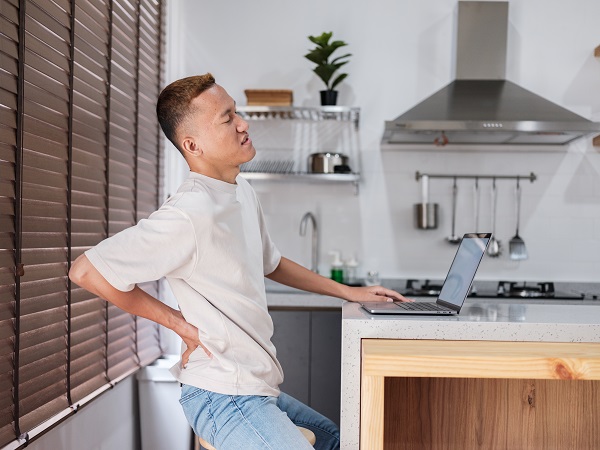Pain is the body’s way of communicating to you a problem. It brings immediate attention to parts of yourbody where the sensation is felt. However, pain is also an awful emotional and physical experience.It has a long list of causes and is experienced in varying degrees indifferent individuals.While pain is felt in differing levels, they can be categorised. The most common way of classifying pain is depending on its duration. Intense, short-lived pain are known as acute pain, and pain that lasts more than three months can be classified as chronic pain.

Sprained ankle is often a common sports injury.
Acute pain comes suddenly, usually in relatively intense levels. They are often caused by something specific and can last up to three months.
Common causes of acute pain include:

Having incorrect posture while working?
Chronic pain lasts anywhere from more than three months to years. It is a type of pain that continues even after the recovery of an injury. Sometimes, chronic pain can even begin with no known cause.
Common causes of chronic pain include:
Unlike acute pain, chronic pain differs in pain duration. They can persist day after day or disappear one day. Chronic pain can be described in several ways:
In some situations, pain may not be the only symptom of chronic pain. Fatigue, mood changes, weakness and insomnia are other symptoms that may come with chronic pain.
Without proper management, chronic pain can negatively impact your life. As such, people with chronic pain may develop symptoms of anxiety or depression.
According to a study done by the World Health Organization, individuals who live with persistent pain are four times more likely than those without pain to suffer from depression or anxiety. These individuals are also more than twice as likely to have difficulty working.
A study done in Singapore found that the prevalence rate for having pain for at least 3 out of past 6 months was 8.7%. This meant more than 300,000 adults were currently suffering from chronic pain. The study also observed a strong relationship between increasing age with pain prevalence especially for those above 65 years old.
Two studies also discussed how chronic pain has negatively impacted the following:

Massage helps relax tense muscles and lower pain levels
It is vital to practise managing pain to keep them at bearable levels to improve our quality of life.
Common pain management methods include pain medicine, acupuncture, physical therapy, yoga and more.
Pain Medicine – While pain medicine has been widely prescribed and consumed, these drugs may have side effects when consumed regularly over a long period.
For example, nonsteroidal anti-inflammatory drugs (NSAIDs) such as Aspirin may cause bleeding in the stomach when consumed for a long time. Other common NSAIDs like Ibuprofen and Naproxen can also damage the stomach and kidney if consumed regularly over a long period. That said, painkillers are no alternatives to NSAIDs.
Paracetamol, also known as Acetaminophen, is a widely used over-the-counter drug. It is known to cause liver damage when excessively ingested.
Opioids are powerful painkillers and are often prescribed for people who undergone recent surgery, had a painful injury or cancer. However, it has commonly been cited to cause constipation, and has other more severe side effects like depression, addiction and weakened immune system. The highly addictive nature of opioid led to the Opioid Epidemic in United States where more than 10 million people misused their opioid prescriptions in 2018 and 70,630 people died from opioid overdose in 2019. The United States Department of Health and Human Services declared a public health emergency in 2017 and laid out strategies to combat the Opioid Crisis.
Non-medicinal method of pain-relief – For acute pain, common pain relief methods include hot packs for joint or muscle injuries, and ice packs to help reduce swelling.
Chronic pain, however, may require a combination of treatment methods and therapies to minimise pain levels.
These methods include physical therapy, yoga, pilates and massage, which require consistent effort to maintain to reap results.
Other methods that may help relief pain without medication relatively fast include invasive methods like acupuncture, or non-invasive methods like Transcutaneous Electrical Nerve Stimulation (TENS).
TENS offers a targeted drug-free solution to relieve muscle & joint pain. TENS has been used since 1974, and is a pain therapy offered by various healthcare professionals such as physiotherapists and pain specialists today.
Click here to read more about Pain Treatment with TENS.
|
Previous article What to do when you have Muscle Aches & Stiffness |
Next article Pain Treatment with TENS |